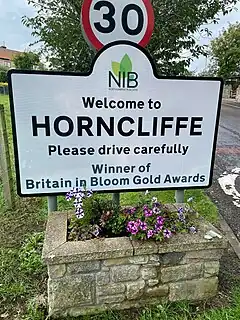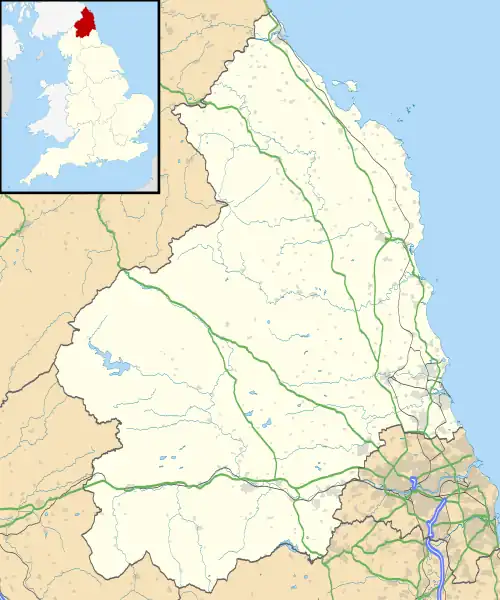| Horncliffe | |
|---|---|
 Horncliffe | |
 Horncliffe Location within Northumberland | |
| Population | 403 (2011 census)[1] |
| OS grid reference | NT925495 |
| District | |
| Shire county | |
| Region | |
| Country | England |
| Sovereign state | United Kingdom |
| Post town | BERWICK UPON TWEED |
| Postcode district | TD15 |
| Police | Northumbria |
| Fire | Northumberland |
| Ambulance | North East |
| UK Parliament | |
Horncliffe is a village in the county of Northumberland, England. It lies on the south bank of the River Tweed about 5 miles (8 km) south west of Berwick-upon-Tweed, and about 3 miles (5 km) north east of Norham and is the most northerly village in England.
History
Horncliffe is the most northerly village in England, built on a cliff above the banks of the River Tweed which forms the border with Scotland. It overlooks a majestic curve of the river, a sweeping bend such as Norse raiders knew as "Horna", hence its name. There is evidence of Iron Age settlements around Horncliffe and cropmarks to the north of the village suggest a possible Roman Fort. In the mediaeval period the village lay to the south-west of the modern village. It was probably a quiet settlement of fishermen and agricultural labourers, but in 1546 during the unrest between the English and the Scots at the end of Henry VIIIs reign, the Scottish and French crossed the Tweed and burned Horncliffe and its mill to the ground. The English Civil War brought Royalists and Parliamentarian troops to the area and in 1639 the army of King Charles I camped along the south of the river near to the area of Chain Bridge towards "Ourde" (now named Ord). This is also seen in a "mapp of King Charles his campe" dated 1639 which is unusually drawn South to North and shows the village was known as "Hauteley". Past visitors to Horncliffe would seek out a low thatched cottage that is said to have sheltered Oliver Cromwell when his army crossed the Tweed. In the 18th and 19th centuries Horncliffe grew and some fine farms were built such as Horncliffe Mains. The Palladian Horncliffe House was built in 1800 and the Union Chain Bridge constructed in 1820, designed by Captain Samuel Brown RN, the world's first vehicle carrying suspension bridge. Many of the oldest houses in the village seen today, were built at this time. Into the 20th century salmon fishing continued to flourish and the village had many amenities including a church, school shop, post office and blacksmith as well as a pub. Except for the pub, all these have sadly disappeared, but though a peaceful village with delightful walks around the river, Horncliffe has a lively and thriving community centred around the village Memorial Hall, and the soon to be re-opened, the Fishers Arms Public House, our community owned pub.
Governance
Horncliffe is in the parliamentary constituency of Berwick-upon-Tweed.
Transport
Borders Buses route 67 provides a number of services a day each way to/from Berwick-upon-Tweed railway station.
References
- ↑ "Parish population 2011". Retrieved 30 June 2011.
External links
![]() Media related to Horncliffe at Wikimedia Commons
Media related to Horncliffe at Wikimedia Commons